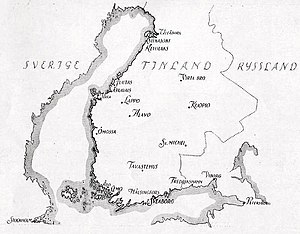Finnish War
| Finnish War | |||||||||
|---|---|---|---|---|---|---|---|---|---|
| Part of Russo–Swedish Wars and Napoleonic Wars (Franco-Swedish War) | |||||||||
 Map of notable locations in Finland during the war |
|||||||||
|
|||||||||
| Belligerents | |||||||||
|
|
|
||||||||
| Commanders and leaders | |||||||||
|
Fyodor Buxhoeveden Bogdan von Knorring Pyotr Bagration Barclay de Tolly Nikolay Ivanovich Demidov |
Wilhelm Mauritz Klingspor Carl Johan Adlercreutz Georg Carl von Döbeln |
||||||||
| Strength | |||||||||
| August 1808: 95,000+ soldiers | August 1808: 36,000+ soldiers | ||||||||
The Finnish War was fought between the Kingdom of Sweden and the Russian Empire from February 1808 to September 1809. As a result of the war, the eastern third of Sweden was established as the autonomous Grand Duchy of Finland within the Russian Empire. Other notable effects were the Swedish parliament's adoption of a new constitution and the establishment of the House of Bernadotte, the new Swedish royal house, in 1818.
After the Russian Emperor Alexander I concluded the 1807 Treaty of Tilsit with Napoleon, Alexander, in his letter on 24 September 1807 to the Swedish King Gustav IV Adolf, informed the king that the peaceful relations between Russia and Sweden depended on Swedish agreement to abide by the limitations of the Treaty of Tilsit which in practice meant that Sweden would have been required to follow the Continental System. The king, who viewed Napoleon as the Antichrist and Britain as his ally against Napoleon's France, was apprehensive of the system's ruinous consequences for Sweden's maritime commerce. He instead entered into negotiations with Britain in order to prepare a joint attack against Denmark, whose Norwegian possessions he coveted.
...
Wikipedia
